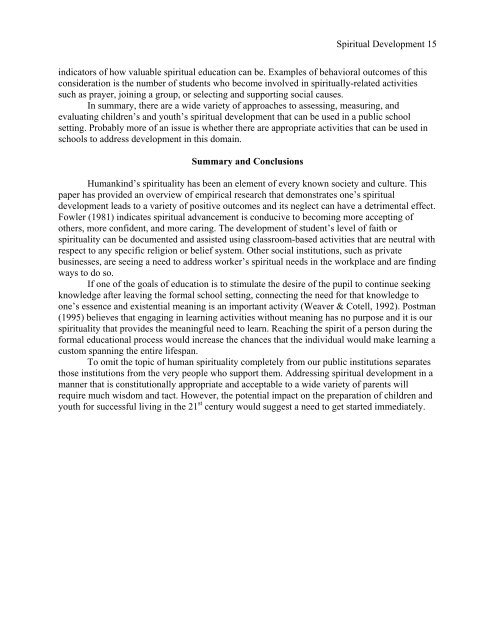The Gift of Spirituality
The Gift of Spirituality
The Gift of Spirituality
You also want an ePaper? Increase the reach of your titles
YUMPU automatically turns print PDFs into web optimized ePapers that Google loves.
Spiritual Development 13<br />
One example <strong>of</strong> a quantitative spiritual assessment tool is the previously mentioned Index<br />
<strong>of</strong> Core Spiritual Experiences (INSPIRIT) developed by Kass (1996). <strong>The</strong> focus <strong>of</strong> his study was<br />
the impact <strong>of</strong> spirituality on health. INSPIRIT is a self-test that provides quantitative results <strong>of</strong> a<br />
connection with one’s spiritual core. While there are concerns with this type <strong>of</strong> assessment tool,<br />
the instrument is widely used and can bring the participant to a greater level <strong>of</strong> self-awareness.<br />
<strong>The</strong> test does refer to a Supreme Being, but provides the participant with a definition that can be<br />
applied to other belief systems. <strong>The</strong> INSPIRIT test does address the relationship between self<br />
and others. Integrating INSPIRIT into the classroom setting would be simple and the results<br />
possibly meaningful to the participants. However, the scope <strong>of</strong> the participant’s spiritual<br />
knowledge may be limited.<br />
Another established quantitative assessment tool is the Spiritual Well-Being Scale<br />
(Buffor, Paloutzian, & Ellison, 1991; Paloutzian & Ellision, 1982). This assessment tool has two<br />
dimensions: religious and existential. It is a 20-item self-administered test that yields a total<br />
score, a religious well-being summed score, and a summed score for the existential well-being. It<br />
has a test-retest reliability <strong>of</strong> .93; the internal consistency coefficients ranged from .94 to .89 in 7<br />
different studies (Bufford, Paloutzian, & Ellison).<br />
Berg (1997) developed an online assessment instrument based on the work <strong>of</strong> McSherry<br />
(1987). <strong>The</strong> instrument provides scores for strength <strong>of</strong> religious belief, spiritual injury, and a<br />
series <strong>of</strong> scores for types <strong>of</strong> stress. No reliability data are available for the instrument.<br />
Qualitative measures that are more oriented to open-ended questions and focus more on<br />
process can be used to supplement forced-choice data. Kessler (2000) suggests having students<br />
anonymously ask “mystery questions” dealing with topics they are curious or worried about or<br />
simply wonder about. A first step when working with groups is to spend some time developing a<br />
sense <strong>of</strong> trust among the students. Rules must be established and practiced so that, when the<br />
facilitator reads an anonymously-provided question and solicits students’ thoughts, others show<br />
respect and consideration. A review <strong>of</strong> student questions provides the facilitator with an<br />
overview <strong>of</strong> the types <strong>of</strong> issues that are <strong>of</strong> interest to a particular group. Having students reflect<br />
what they have learned about these important questions at the end <strong>of</strong> unit or course that deals<br />
with these topics can be a valuable resource for evaluating student learning.<br />
Hodge (2001) provides an overview <strong>of</strong> qualitative assessment tools developed by Nino<br />
(1997), Pruyser (1993), and Fitchett’s (1993). Nino’s spiritual quest is based on 10 items that<br />
lead the participant to create a detailed autobiographical story. Pruyser’s model includes seven<br />
categories: things that are sacred, hope and trust, commitment, thankfulness, guilt,<br />
connectedness, and purpose in life and work. When utilizing this instrument, the instructor<br />
listens to students’ stories, asking questions that relate to the seven themes. Fitchett’s approach<br />
also focuses on seven areas: beliefs and meaning, vocation and consequences, experiences and<br />
emotion, courage and growth, ritual and practice, community, authority and guidance, which<br />
provide an understanding <strong>of</strong> the student’s spirituality in a broader context. In each case, the<br />
authors include items that relate to the three domains discussed by Hamilton and Jackson (1998):<br />
a relationship to one’s self, a relationship to others, and a relationship to a Higher Power.<br />
Hodge (2001) proposes a spiritual framework for the purpose <strong>of</strong> counseling. His twodimensional<br />
framework has a narrative and an interpretive aspect. <strong>The</strong> narrative framework is<br />
composed <strong>of</strong> three questions that provide information on the subject’s religious or spiritual<br />
tradition and experience. <strong>The</strong> interpretive anthropological framework is multidimensional and<br />
provides data on the subject’s understanding or explanation <strong>of</strong> his or her spiritual beliefs and<br />
activities. <strong>The</strong> interpretive portion is made up <strong>of</strong> six topical questions that focus on affect,

















